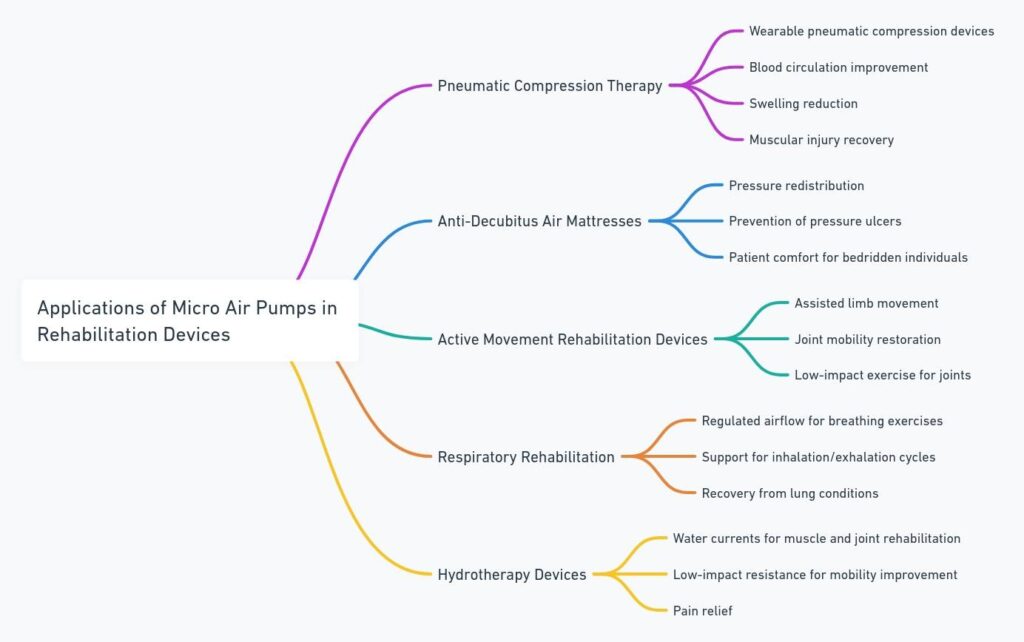
Are you looking to understand how micro air pumps are transforming rehabilitation devices? Patients recovering from injuries need precise and comfortable therapy solutions. Unfortunately, many traditional rehabilitation tools lack the flexibility and control needed for optimal results. This is where micro air pumps come in—they provide the accuracy and reliability needed for modern rehabilitation.
Micro air pumps are used in many rehabilitation devices to improve treatment precision and patient comfort. These pumps help control air pressure, making therapy effective and efficient. In this post, I’ll break down how micro air pumps work, the types available, and how we use them in rehabilitation devices.
Curious to learn more? Let’s dive into the specifics.
Understanding Micro Air Pumps
Micro air pumps are miniature devices designed to generate airflow and pressure, typically used for pushing or pulling air in controlled environments. They operate based on positive or negative pressure mechanisms, driven by electric motors that either compress or draw in air via a diaphragm or piston. This capability to regulate air pressure and flow makes them crucial in applications where accuracy and reliability are key, such as medical and rehabilitation equipment.
Micro air pumps have become indispensable in rehabilitation due to their versatility and reliability. They offer controlled pressure, allowing rehabilitation equipment to assist in patient therapy more effectively. This ability to regulate both pressure and airflow is especially important for consistent treatment quality, which is a critical factor in successful rehabilitation outcomes.
Types of Micro Air Pumps Used in Rehabilitation

In rehabilitation devices, two primary types of micro air pumps are often used:
- Micro Diaphragm Pumps: These pumps are designed for applications requiring consistent or pulsed airflow. They use a flexible diaphragm to create air movement, making them perfect for therapeutic devices like alternating pressure pads used in beds for bedridden patients.
- Micro Piston Pumps: Known for their higher pressure capabilities, micro piston pumps are used in scenarios where robust air pressure is needed. They deliver a powerful, steady flow of air, often utilized in advanced rehabilitation systems, such as those used for limb therapy.
Applications in Rehabilitation Devices
The applications of micro air pumps in rehabilitation devices are diverse and innovative, allowing for more efficient and comfortable treatment options. Here are some specific examples:

- Pneumatic Compression Therapy: Micro air pumps are essential in wearable pneumatic compression devices, such as pressure therapy sleeves for the legs or arms. These devices apply alternating air pressure, which helps stimulate blood circulation, reduce swelling, and aid in the recovery of muscular injuries. By delivering controlled compression, the pumps assist in preventing deep vein thrombosis and promoting lymphatic drainage.
- Anti-Decubitus Air Mattresses: For patients who are bedridden or have limited mobility, pressure ulcers can be a significant concern. Air pumps used in anti-decubitus air mattresses help alleviate this problem by constantly adjusting the air pressure in different sections of the mattress. This dynamic pressure redistribution minimizes prolonged pressure on any one part of the body, significantly reducing the risk of pressure ulcers.
- Active Movement Rehabilitation Devices: Miniature pumps are also employed in rehabilitation systems that aid active limb movement. These systems often use air bladders to assist with gentle flexing or extending of joints in the knee, hip, or elbow. The controlled inflation and deflation of air chambers provide patients with low-impact, consistent exercise, helping restore joint mobility without causing additional stress or injury.
- Respiratory Rehabilitation: Certain respiratory rehabilitation devices utilize small air pumps to provide precisely regulated airflow, aiding patients in breathing exercises. These pumps create the necessary pressure to assist in inhalation and exhalation cycles, especially for patients recovering from lung conditions or those requiring respiratory training.
- Hydrotherapy Devices: Micro air pumps are increasingly used in hydrotherapy devices, where controlled air pressure helps create water currents. These gentle currents provide resistance and aid in the rehabilitation of muscles and joints in a low-impact environment, making hydrotherapy a highly effective treatment for mobility improvement and pain relief.
Advantages of Micro Air Pumps in Rehabilitation
Micro air pumps offer several benefits that make them uniquely suited for rehabilitation devices:
- Compact Design: Their small size allows them to be integrated seamlessly into portable or wearable devices, which is essential for patient comfort and convenience.
- Precision and Reliability: These pumps provide consistent and precise air pressure, crucial for maintaining the effectiveness of therapy over time.
- Customizability: Micro air pumps can be easily adjusted or customized to meet specific therapeutic requirements, providing versatility across a wide range of rehabilitation devices.
Advanced Features of Micro Air Pumps
Today's micro air pumps come with a host of advanced features that make them even more suitable for rehabilitation applications:
- Noise Reduction: Many micro air pumps are designed to operate quietly, an essential feature for patient comfort, especially in home care settings. Noise reduction ensures that patients can undergo therapy without added stress or discomfort.
- Energy Efficiency: Micro air pumps are becoming increasingly energy-efficient, which is beneficial for battery-powered portable rehabilitation devices. This efficiency helps prolong device usage between charges, making rehabilitation more accessible and continuous.
- Real-time Monitoring: Some micro air pumps are integrated with sensors that provide real-time feedback on pressure and flow rates. This data can be monitored to adjust therapy settings precisely, ensuring patients receive optimal treatment.
Conclusion
Mini air pumps play a vital role in modern rehabilitation devices, improving both the quality and effectiveness of treatment. From enhancing blood circulation to preventing pressure sores and aiding respiratory therapy, these pumps provide precise control that is crucial for patient care. As rehabilitation technology continues to evolve, micro air pumps will undoubtedly remain at the forefront, driving innovation in patient comfort and recovery outcomes.
If you are interested in integrating micro air pumps into your rehabilitation devices, feel free to reach out. Shenzhen Boden Technology specializes in customizable solutions tailored to meet the unique needs of your application.
For further reading, check out our detailed resource on Micro Air Pump.


